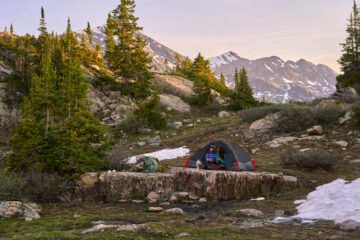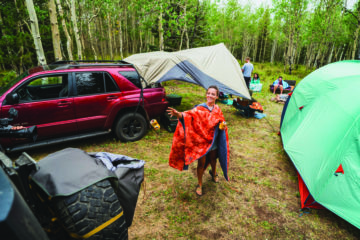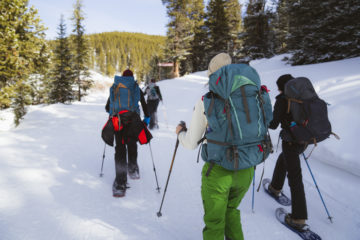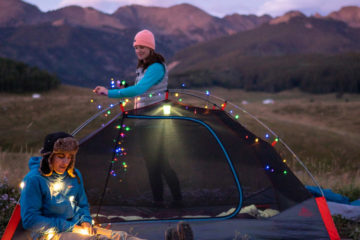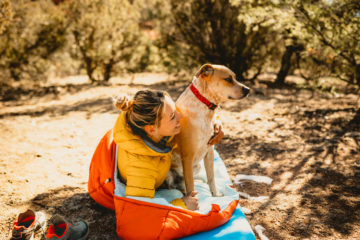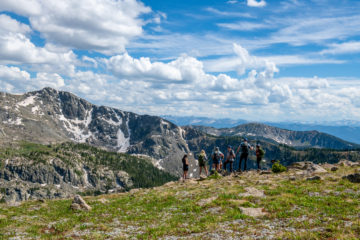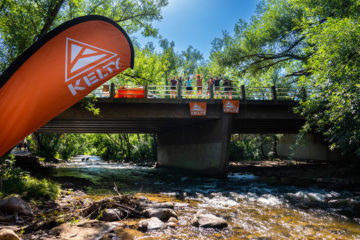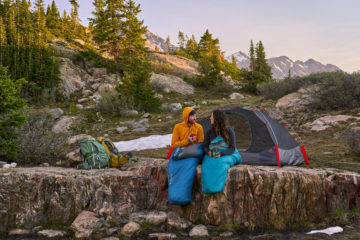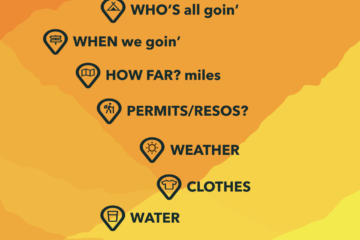A guide to picking the right sleeping bag for your next adventure
Attention, newbies and fellow seasoned nature lovers! When it comes to spending the night under the stars, two things are essential to ensuring that everyone comes back for more: warmth and comfort. And, while your tent or shelter is obviously an important part of the picture, your sleeping bag can mean the difference between a great day enjoying the glories of the wilderness—and waking up in a less than ideal situation. Here’s how to choose a sleeping bag for any kind of adventure!

How to Choose a Sleeping Bag
A. SHAPE: Sleeping bags come in three basic shapes: rectangular, semi-rectangular and mummy. Rectangular sleeping bags are shaped as you’d imagine—with right angles and the roomy interior this geometry entails. Larger, bulkier and heavier than bags made for the backcountry, rectangular bags are best suited for car camping and festivals with close-in parking. For these reasons, they’re often made with less technical, more affordable materials.
OUR PICK: Galactic 30: Can a rec bag be sexy? Yup. Go ahead and get down with our down-filled Galactic Bag… It’s compact enough for you to carry for nights on the trail, and roomy enough to stretch out under starry nights close to your car. And when the moment is right to spend a cuddly night, two of these bags easily zip together so you can spoon in a double-wide.
Semi-rectangular sleeping bags cross the middle ground between sleepover and sojourn, with a shape that tapers slightly from head to foot. They’re roomier than rectangular bags, and may or may not be hooded for warmth. These hybrid-shaped bags usually feature higher quality (but not exactly premium) materials. Overall, they’re great all-around bags for travel or car camping, but may not be light or warm enough for long-term backcountry adventures.
OUR PICK: Tru.Comfort. Whether you’re snoozing or snuggling, you want two things from your sleeping bag: contact with bae, and control over your temperature. Our Doublewide lets you do you…times two. Wider than a standard double with a hood that accommodates two standard-sized pillows, the Tru.Comfort Doublewide also gives each person their own personal snuggle blanket and foot vent. Not in the mood for ZZZs? The Doublewide is the best way to get down without getting dirty in the outdoors.
As the name suggests, mummy sleeping bags are shaped like a swaddled human body—and that’s exactly what you’ll be when you zip in! Since they fit closer to the body, starfish sleepers will sacrifice some comfort, especially if you’re the tossing-and-turning type. But in return, you’ll get the lightest and most heat-efficient shape on the market. Because mummy bags are the go-to shape for backpacking, where lightness and warmth are paramount, these typically feature premium fills and fabrics for utmost all-around efficiency. More about that below.
OUR PICK: Cosmic Down. Available in 0- and 20-degree versions, this 3-season superstar features trapezoidal baffles to help you retain even MORE heat—plus a natural-fit footbox for happy feet, a zipper draft tube to keep cold air out and a stuff-sack for quick departures.
B. INSULATION: SYNTHETIC. Synthetic sleeping bag insulation is fine-denier man-made fibers that behave much like organic down. It’s the ultimate bang-for-buck fill: more affordable and more water resistant than natural down, it also dries faster and performs better when damp.
On the downside: while cost effective and reliably high performing, synthetic down is heavier, bulkier and less durable—the loft degrading just a bit every time it’s compressed.
DOWN. Made from the fluffy layer of insulation underneath a goose’s exterior feathers, down sleeping bag insulation is light, durable, breathable, compressible…if a bit more expensive than synthetic sleeping bag insulation options. It’s the stuffing of choice for cold, DRY conditions. In the “cons” column, natural down insulation can get clumpy when wet, takes longer to dry, requires more care when cleaning—and tends to be a bit more pricey, too.
SIDE NOTE: Clothing. Two of the most common rookie mistakes you can make when trying to stay warm while camping: wearing too much clothing, or the wrong kind of clothing, to bed. Although it may seem counterintuitive, bundling up like Ralphie won’t keep you warmer! Those extra bulky layers can actually prevent your body heat from transferring into your sleeping bag insulation, where it will be trapped and used to keep you toasty all night long.
In the backcountry, moisture is also the enemy of warmth. So it’s wise to choose strategic base layers made from heat-efficient, moisture-wicking fabrics like merino wool or synthetic, more technical fabrics like Capilene. And, as on the trail—it’s wise to put the kibosh on cotton.
C. FABRICS. Sleeping bag fabrics have come a long way since the days of heavy flannels festooned with friendly forest creatures! There are a LOT of advanced materials out there, with a lot of confusing acronyms and initials, so we’ll keep it simple. Kelty uses a range of ultra-durable, feather-light, buttery-soft, water-repellent nylon and polyester materials for our liners and shells—all produced with minimum possible impact on the environment.
D. TEMPERATURE RATING. Nearly all major sleeping bag manufacturers use the EN (European Norm) testing standard for sleeping bag temperature ratings. Generally, your bag’s number rating will be the lowest outside temperature at which you can sleep comfortably.
Beyond that, the system is pretty self-explanatory. For summertime adventures at lower elevations, you can probably get by with a sleeping bag rating in the range of 30–50°F. Sleeping bags rated from 5–29°F are considered three-season bags; this range is highly versatile and will have the widest selection across most outdoor gear brands.
At the upper limit of warmth, the range is -40–+4°, and take it from us: these bags are hot as breakfast! If you’re planning a mountaineering expedition, ski tour or winter camping trip, you’ll likely need one of these guys—which offer serious insulation as well as other nifty features to keep you from freezing on single-digit or negative-temps nights. And, speaking of features…
E. SLEEPING BAG DESIGN FEATURES. You’re going to see a lot of new terminology when you’re shopping for a sleeping bag—so let’s get you brushed up on the basics!
Compression Bag or Stuff Sack: With the exception of some rec bags, most sleeping bags come with a stuff sack. This is the tiny bag into which you will cram your sleeping bag, in order to get it to a trim, portable carry size. It doesn’t look like it will fit, but it will. In between adventures, you’ll want to get a larger storage sack; this will give your sleeping bag insulation room to breathe, and protect synthetic down from gradual compression degradation.
Hood and Draft Collar. Our heads lose heat faster than any other part of the body. That’s why you’ll find that most mummy sleeping bags (and some semi-rectangular bags ) come with a hood to lock in warmth, and a draft collar to keep chilly air from sneaking in around your shoulders.
Baffle: On your sleeping bag, as with your favorite puffer coat, the insulation needs stitching to make sure the feathers or fibers don’t migrate within the lining—creating clumps and cold spots. The stitching creates cozy little chambers in which the insulation can fully loft, or fluff up, for maximum coziness. Fun fact: our award-winning Cosmic bag features innovative trapezoidal baffles that are proven to maintain consistent warmth on even the chilliest nights.
Footbox: Several Kelty sleeping bags feature natural-fit footboxes—means your tired dogs have plenty of room to move, without losing that precious heat.
Stash Pocket: There’s nothing worse than needing your headlamp or lip balm in the wee hours, and having NO LITERAL idea where they might be. We’ve added zippered stash pockets to many of our sleeping bags, so you’ll always have the essentials at your fingertips.
Zippers: Your sleeping bag’s zipper may have a few cool features. Look for anti-snag design; a draft guard, which gives you extra protection from cold air around this vulnerable part of your bag; and locking capabilities, so it doesn’t slip open if you happen to roll around in the night.
Finally—Work the System!
If you’re an absolute beginner—and if you are, WELCOME—you may not already know that your sleeping bag and sleeping pad are basically equal partners in ensuring backcountry bliss. Your sleeping bag helps to insulate you from the cold air, and your sleeping pad helps to form an additional protective layer between your (hopefully) warm body and the cold, hard ground; this is important not just for temperature regulation, but to provide cushioning for a comfy sleep.
Stay tuned for our thoughts on how to choose a sleeping pad…coming your way soon! And be sure to follow us @keltyusa for all kinds of cool camp content. See you out there!
